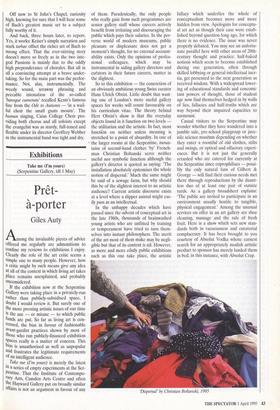Exhibitions
Take me (I'm yours) (Serpentine Gallery, till 1 May) Pret-
Giles Auty
Among the invaluable pieces of advice offered me regularly are admonitions to confine my reviews to exhibitions I enjoy. Clearly the role of the art critic seems a simple one to many people. However, how a critic might by such means give any idea at all of the context in which living art takes Place remains unexplained, and probably unconsidered.
If the exhibition now at the Serpentine Gallery were taking place in a privately-run rather than publicly-subsidised space, I doubt I would review it. But surely one of the more pressing artistic issues of our time is the use — or misuse — to which public funds are put. So far as living art is con- cerned, the bias in favour of fashionable avant-gardist practices shown by most of those who run publicly-financed exhibition spaces really is a matter of concern. This bias is unauthorised as well as unpopular and frustrates the legitimate requirements of an intelligent audience. Take me (I'm yours) is merely the latest in a series of empty experiments at the Ser- pentine. That the Institute of Contempo- rary Arts, Camden Arts Centre and often the Hayward Gallery put on broadly similar affairs is not an argument in favour of any of them. Paradoxically, the only people who really gain from such programmes are senior gallery staff whose careers actively benefit from irritating and discouraging the public which pays their salaries. In the per- verse world of modern museums, public pleasure or displeasure does not get a moment's thought, for no external account- ability exists. Only the opinions of profes- sional colleagues, which may be instrumental in aiding gallery directors and cufators in their future careers, matter in the slightest.
So to this exhibition — the concoction of an obviously ambitious young Swiss curator Hans Ulrich Obrist. Little doubt that wast- ing one of London's more useful gallery spaces for weeks will count favourably on his curriculum vitae. The theory behind Herr Obrist's show is that the everyday objects found in it function on two levels the utilitarian and the artistic. In fact, most function on neither unless meaning is stretched to a point of absurdity. In one of the larger rooms at the Serpentine, moun- tains of second-hand clothes 'by' French- man Christian Boltanski serve neither useful nor symbolic function although the gallery's director is quoted as saying: 'The installation absolutely epitomises the whole notion of dispersal.' Much the same might be said of a sewage farm, but why should this be of the slightest interest to an artistic audience? Current artistic discourse exists at a level where a slipper animal might eas- ily pass as an intellectual.
In the unhappy decades which have passed since the advent of conceptual art in the late 1960s, thousands of brainwashed young artists who are unfitted by training or temperament have tried to turn them- selves into instant philosophers. The merit of the art most of them make may be negli- gible but that of its content is nil. However, as more and more c5stly public exhibitions such as this one take place, the artistic fallacy which underlies the whole of conceptualism becomes more and more hidden from view. Apologists for conceptu- al art act as though their case were estab- lished beyond question long ago, for which there is no evidence. The issue was never properly debated. You may see an unfortu- nate parallel here with other areas of 20th- century thought and practice: half-baked notions which seem to become established during one generation, often through skilled lobbying or general intellectual iner- tia, get presented to the next generation as received wisdom. With a widespread lower- ing of educational standards and concomi tant powers of thought, those of student age now find themselves hedged in by walls of lies, fallacies and half-truths which, are way beyond their impaired capacities to surmount.
Casual visitors to the Serpentine may wonder whether they have wandered into a jumble sale, pre-school playgroup or juve- nile science museum depending on whether they enter a roomful of old clothes, stilts and swings, or optical and olfactory experi- ences. But it is not just the generally retarded who are catered for currently at the Serpentine since coprophiliacs — possi- bly the only natural fans of Gilbert & George — will find their curious needs met there through reproductions by the daunt- less duo of at least one pair of outsize turds. As a gallery broadsheet explains: The public are invited to participate in an environment usually hostile to tangible, physical engagement.' Among the unusual services on offer in an art gallery are shoe cleaning, massage and the sale of fresh fruit. Here is a show which sets new stan- dards both in vacuousness and curatorial complacency. It has been brought to you courtesy of Absolut Vodka whose earnest search for an appropriately modish artistic product to sponsor has merely landed them in bed, in this instance, with Absolut Crap.
`Dispersal' by Christian Boltanski, 1995


























































 Previous page
Previous page